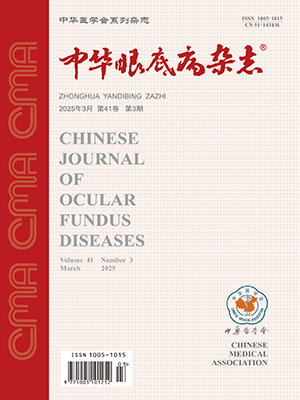| 1. |
Baba T, Ohno-Matsui K, Futagami S, et al. Prevalence and characteristics of foveal retinal detachment without macular hole in high myopia[J]. Am J Ophthalmol, 2003, 135(3): 338-342. DOI: 10.1016/s0002-9394(02)01937-2.
|
| 2. |
Takano M, Kishi S. Foveal retinoschisis and retinal detachment in severely myopic eyes with posterior staphyloma[J]. Am J Ophthalmol, 1999, 128(4): 472-476. DOI: 10.1016/s0002-9394(99)00186-5.
|
| 3. |
Shimada N, Ohno-Matsui K, Baba T, et al. Natural course of macular retinoschisis in highly myopic eyes without macular hole or retinal detachment[J]. Am J Ophthalmol, 2006, 142(3): 497-500. DOI: 10.1016/j.ajo.2006.03.048.
|
| 4. |
Peng KL, Kung YH, Hsu CM, et al. Surgical outcomes of centripetal non-fovea-sparing internal limiting membrane peeling for myopic foveoschisis with and without foveal detachment: a follow-up of at least 3 years[J]. Br J Ophthalmol, 2020, 104(9): 1266-1270. DOI: 10.1136/bjophthalmol-2019-314972.
|
| 5. |
Ikuno Y, Sayanagi K, Soga K, et al. Foveal anatomical status and surgical results in vitrectomy for myopic foveoschisis[J]. Jpn J Ophthalmol, 2008, 52(4): 269-276. DOI: 10.1007/s10384-008-0544-8.
|
| 6. |
Hattori K, Kataoka K, Takeuchi J, et al. Predictive factors of surgical outcomes in vitrectomy for myopic traction maculopathy[J]. Retina, 2018, 38(Suppl 1): S23-30. DOI: 10.1097/IAE.0000000000001927.
|
| 7. |
Benhamou N, Massin P, Haouchine B, et al. Macular retinoschisis in highly myopic eyes[J]. Am J Ophthalmol, 2002, 133(6): 794-800. DOI: 10.1016/s0002-9394(02)01394-6.
|
| 8. |
Bando H, Ikuno Y, Choi JS, et al. Ultrastructure of internal limiting membrane in myopic foveoschisis[J]. Am J Ophthalmol, 2005, 139(1): 197-199. DOI: 10.1016/j.ajo.2004.07.027.
|
| 9. |
VanderBeek BL, Johnson MW. The diversity of traction mechanisms in myopic traction maculopathy[J]. Am J Ophthalmol, 2012, 153(1): 93-102. DOI: 10.1016/j.ajo.2011.06.016.
|
| 10. |
Kobayashi H, Kishi S. Vitreous surgery for highly myopic eyes with foveal detachment and retinoschisis[J]. Ophthalmology, 2003, 110: 1702-1707. DOI: 10.1016/S0161-6420(03)00714-0.
|
| 11. |
Zheng B, Chen Y, Chen Y, et al. Vitrectomy and internal limiting membrane peeling with perfluoropropane tamponade or balanced saline solution for myopic foveoschisis[J]. Retina, 2011, 31(4): 692-701. DOI: 10.1097/IAE.0b013e3181f84fc1.
|
| 12. |
Wang L, Wang Y, Li Y, et al. Comparison of effectiveness between complete internal limiting membrane peeling and internal limiting membrane peeling with preservation of the central fovea in combination with 25G vitrectomy for the treatment of high myopic foveoschisis[J/OL]. Medicine, 2019, 98(9): e14710[2019-03-01]. https://pubmed.ncbi.nlm.nih.gov/30817612/. DOI: 10.1097/MD.0000000000014710.
|
| 13. |
Shiraki N, Wakabayashi T, Ikuno Y, et al. Fovea-sparing versus standard internal limiting membrane peeling for myopic traction maculopathy: a study of 102 consecutive cases[J]. Ophthalmol Retina, 2020, 4(12): 1170-1180. DOI: 10.1016/j.oret.2020.05.016.
|
| 14. |
Lee CL, Wu WC, Chen KJ, et al. Modified internal limiting membrane peeling technique (maculorrhexis) for myopic foveoschisis surgery[J/OL]. Acta Ophthalmol, 2017, 95(2): e128-131[2016-06-20]. https://pubmed.ncbi.nlm.nih.gov/27320761/. DOI: 10.1111/aos.13115.
|
| 15. |
Shimada N, Sugamoto Y, Ogawa M, et al. Fovea-sparing internal limiting membrane peeling for myopic traction maculopathy[J]. Am J Ophthalmol, 2012, 154(4): 693-701. DOI: 10.1016/j.ajo.2012.04.013.
|
| 16. |
Figueroa MS, Ruiz-Moreno JM, Gonzalez del Valle F, et al. Long-term outcomes of 23-gauge pars plana vitrectomy with internal limiting membrane peeling and gas tamponade for myopic traction maculopathy: a prospective study[J]. Retina, 2015, 35(9): 1836-1843. DOI: 10.1097/IAE.0000000000000554.
|
| 17. |
Tian T, Jin H, Zhang Q, et al. Long-term surgical outcomes of multiple parfoveolar curvilinear internal limiting membrane peeling for myopic foveoschisis[J]. Eye (Lond), 2018, 32(11): 1783-1789. DOI: 10.1038/s41433-018-0178-0.
|
| 18. |
Elwan MM, Abd Elghafar AE, Hagras SM, et al. Long-term outcome of internal limiting membrane peeling with and without foveal sparing in myopic foveoschisis[J]. Eur J Ophthalmol, 2019, 29(1): 69-74. DOI: 10.1177/1120672117750059.
|
| 19. |
Gass JD. Müller cell cone, an overlooked part of the anatomy of the fovea centralis: hypotheses concerning its role in the pathogenesis of macular hole and foveomacualr retinoschisis[J]. Arch Ophthalmol, 1999, 117(6): 821-823. DOI: 10.1001/archopht.117.6.821.
|
| 20. |
Zeng Q, Yao Y, Zhao M. Comparison between fovea-sparing and complete internal limiting membrane peeling for the treatment of myopic traction maculopathy: a systemic review and meta-analysis[J]. Ophthalmic Res, 2021, 64(6): 916-927. DOI: 10.1159/000519021.
|
| 21. |
Ho TC, Chen MS, Huang JS, et al. Foveola nonpeeling technique in internal limiting membrane peeling of myopic foveoschisis surgery[J]. Retina, 2012, 32(3): 631-634. DOI: 10.1097/IAE.0B013E31824D0A4B.
|
| 22. |
Kim KS, Lee SB, Lee WK. Vitrectomy and internal limiting membrane peeling with and without gas tamponade for myopic foveoschisis[J]. Am J Ophthalmol, 2012, 153(2): 320-326. DOI: 10.1016/j.ajo.2011.07.007.
|
| 23. |
Meng B, Zhao L, Yin Y, et al. Internal limiting membrane peeling and gas tamponade for myopic foveoschisis: a systematic review and meta-analysis[J]. BMC Ophthalmol, 2017, 17(1): 166. DOI: 10.1186/s12886-017-0562-8.
|
| 24. |
Yun LN, Xing YQ. Long-term outcome of highly myopic foveoschisis treated by vitrectomy with or without gas tamponade[J]. Int J Ophthalmol, 2017, 10(9): 1392-1395. DOI: 10.18240/ijo.2017.09.10.
|
| 25. |
Yao Y, Qu J, Shi X, et al. Vitrectomy with silicone oil tamponade and without internal limiting membrane peeling for the treatment of myopic foveoschisis with high risk of macular hole development[J/OL]. Front Med (Lausanne), 2021, 8: 648540[2021-05-28]. https://pubmed.ncbi.nlm.nih.gov/34124090/. DOI: 10.3389/fmed.2021.648540.
|




